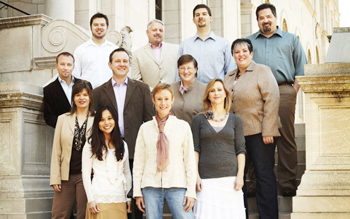by Daniel Hathaway

The eighteen selections the Rose Ensemble sang during their hour-long program included anonymous Czech music from the 11th to 15th centuries, and works by Jan z Jenštejna (ca.1350-1400), Mikołaj Gomółka (b. ca.1535), Mikołaj Zieleński (ca.1550-post 1615), and Vasily Titov (ca.1650-ca.1715) — all names, as Sramek pointed out in his program notes, that have been neglected by Western scholars and performers.
As he wrote, “The shelves of the manuscript libraries and monasteries of Krakow, Moscow, and Prague often remain dusty, either due to lack of interest or perceived inaccessibility.” Not only did the Rose Ensemble blow centuries of accumulated grime off this repertoire, they brought it to such vibrant life that you wanted to know and hear more — much more.
Mixing up the scoring of monophonic chants and songs between men’s and women’s voices, contrasting choral textures with solos, and introducing now and then the sounds of the recorder, drum, and hurdy-gurdy, the Rose singers made ancient tunes sound freshly-composed, and sang with such excellent diction that it was quite easy to follow the printed texts, even in unfamiliar languages.
Among the more striking pieces were Zieleński’s Beata es Virgo; a Magnificat setting with lively fauxbourdon verses interleaved with chant; a free-organum setting of Decet huius cunctis horis by Jenštejna; Titov’s madrigalesque Dostóyno yest; and Zieleński’s positively Venetian setting of the Magnificat for twelve voices (he is reported to have studied with Giovanni Gabrieli). The anonymous 15th-century Czech Salve pater optime was a timely reference to St. Wenceslaus, whose feast day had been celebrated at St. John’s two days earlier.
Each half of the program ended with traditional Ukrainian songs. “The New Joy” and “In Jerusalem” were folksy and deliciously raucous at the end of the first set, but “The Heavens and the Earth” (about celebrating the feast of Christmas) at the end of the concert was almost frightening in its exuberance. In the latter, the Rose Ensemble let everything loose, singing with stentorian levels of vocal tone that brought the audience swiftly to its feet. They wanted more, but what encore could possibly have followed that final song?
Printed programs at St. John’s concerts are always lavish in their documentation. This one helpfully offered both original texts and translations in addition to Jordan Sramek’s thoughtful preface. Perhaps the organizers could spring for a staple or two. Three large, double-sided sheets get a bit messy to handle (and noisy!) without something to hold them together.
Published on ClevelandClassical.com October 6, 2015.
Click here for a printable copy of this article



